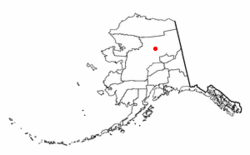Demographics
Stevens Village originally had been “Stevens Camp,” and was so listed in the 1900 Census. [6] It next appeared on the 1910 U.S. Census as the unincorporated village of Stevens. It returned again in 1920, and in 1930, it returned as "Stephens." From 1940–60, it returned again as "Stevens." In 1970, and in every successive census, it has returned as Stevens Village. It was made a census-designated place (CDP) in 1980.
As of the census [7] of 2000, there were 87 people, 35 households, and 15 families residing in the CDP. The population density was 8.4 inhabitants per square mile (3.2/km2). There were 43 housing units at an average density of 4.1 per square mile (1.6/km2). The racial makeup of the CDP was 3.45% White, 95.40% Native American, 1.15% from other races. 6.90% of the population were Hispanic or Latino of any race.
There were 35 households, out of which 28.6% had children under the age of 18 living with them, 2.9% were married couples living together, 31.4% had a female householder with no husband present, and 54.3% were non-families. 45.7% of all households were made up of individuals, and 11.4% had someone living alone who was 65 years of age or older. The average household size was 2.49 and the average family size was 3.63.
In the CDP, the age distribution of the population shows 29.9% under the age of 18, 8.0% from 18 to 24, 31.0% from 25 to 44, 24.1% from 45 to 64, and 6.9% who were 65 years of age or older. The median age was 35 years. For every 100 females, there were 190.0 males. For every 100 females age 18 and over, there were 190.5 males.
The median income for a household in the CDP was $12,500, and the median income for a family was $11,563. Males had a median income of $11,250 versus $0 for females. The per capita income for the CDP was $7,113. There were 60.0% of families and 61.2% of the population living below the poverty line, including 70.8% of under eighteens and 25.0% of those over 64.
This page is based on this
Wikipedia article Text is available under the
CC BY-SA 4.0 license; additional terms may apply.
Images, videos and audio are available under their respective licenses.


